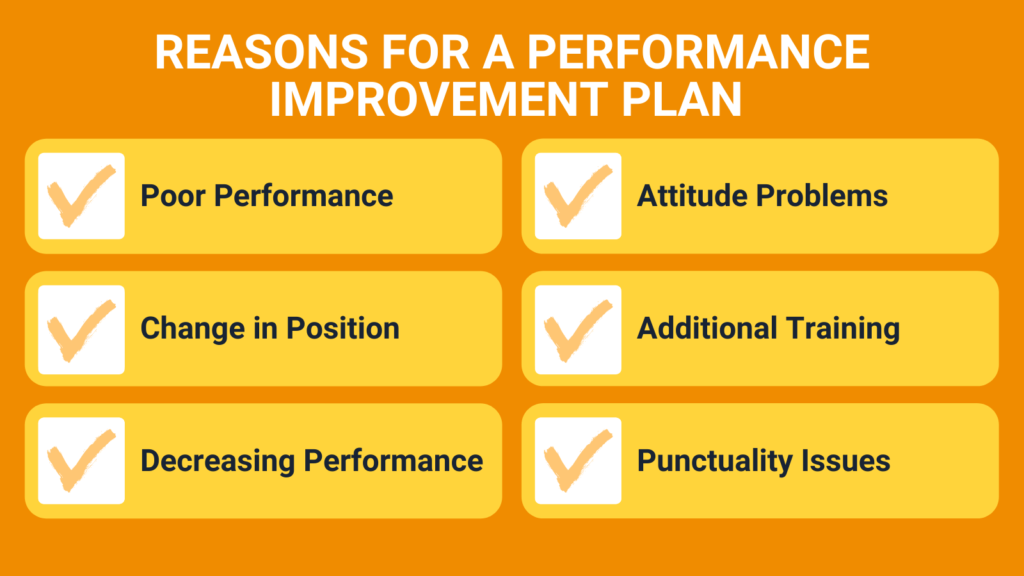Performance Improvement Plans: How To Write Them
Posted by Noel • January 14, 2022 (Last modified January 19, 2023) • 6 min read
Writing performance improvement plans (PIPs) is a formal way to alert an employee that there is an issue with their performance while giving them actionable feedback and goals to improve. PIPs typically outline a timeline for achievement as well as provide the scaffolding they need to improve.
Not every employee is going to meet expectations at every performance review. It is up to HR leaders and managers to help them boost their performance and get back in good standing. Performance improvement plans are effective because they require the employee to take ownership of their performance while still feeling supported by their organization.
Why Are Performance Improvement Plans Important?
Performance improvement plans take a long time to write, often include multiple steps, and require constant feedback. Why is it better to go through all of this than simply fire the employee or allow them to coast along and underperform?
When written properly, performance improvement plans can:
Reduce Employee Churn: When a company has a revolving door of employees, it can destroy company culture. Churn makes it harder for employees to form meaningful relationships with each other, work towards common goals, and feel supported. When people continually leave or get fired, even the best, happiest employees will start looking for other opportunities.
Improve Already Great Performance: A performance improvement plan doesn’t have to be something you only write for employees who are struggling. If someone wants to move up within the company or take on another role, you can write these plans as a stepping stone to get them there. You can also use them to turn around employees who seem to be sliding in performance, though they are still reaching their goals.
Save Time: Turnover costs employers a lot of time and money. Bringing on new employees requires spending time on creating job posts, interviewing applicants, drafting up contract, executing an onboarding process of at least a week, and completing paperwork. Writing a PIP and following up will only take a couple hours if you have the right tools.
When Is An Employee Performance Improvement Plan Appropriate?
Employee performance improvement plans are appropriate in a variety of circumstances. They are most commonly used when an employee is struggling or falling behind in performance.
Managers need to be able to spot signs of underperformance throughout the reviews process or in the general day-to-day of work. If you aren’t sure whether an employee needs a PIP, here are some of the most common signs that one could be helpful:
- Decreasing Engagement
- Avoiding Managers
- Taking A Lot Of Time Off
- Relying Too Much On Coworkers
- Not Meeting Deadlines
- Lashing Out
- Suddenly Changing Personality
Introducing a performance improvement plan can help to right the course for an employee who needs a gentle push in the right direction or to correct smaller problem areas. It also gives HR a chance to talk to the employee to find out if there is something else behind the change in performance.
How To Write The Best Performance Improvement Plan
Writing the best performance improvement plan isn’t easy, but the more you write them, the easier it will become. Putting everything together shouldn’t take too much time, and can be made more efficient by using a performance management tool.
Every company will write plans differently, but the general flow should be similar:
- Determine what the baseline is for a particular role or employee. Be as specific as you can, including all areas of someone’s job.
- Create a way to measure whether or not an employee has reached their goals. One great way to do that is to use the SMART framework to write out your goals.
- Find ways to help your employee. They shouldn’t feel like they are alone in this endeavor. You can include additional training, mentorship, coaching, or tools.
- Create a schedule to check-in with your employee. This could either be in-person or through an online survey or form. Regular check-ins will keep your employee engaged in the plan.
- Talk frankly about the consequences if the employee doesn’t achieve their goals or at least make progress. However, you want to focus on improving them, not reprimanding or punishing them.
Throughout the entire process, it is important to remain kind, calm, and ensure that all of your communications come from a place of improvement. The last thing you want is your employee to believe they are getting fired no matter what they do.
Performance Improvement Plan Process
Typically, a performance improvement plan is part of a series of events that occur around either the performance review process or when an employee is showing signs of underperforming. Most companies will break down the process into a few steps:
- Work with managers and supervisors to determine where the employee needs to focus their improvement efforts.
- The HR leader or supervisor writes the PIP plan.
- A formal meeting is schedule to review the document and ensure the employee understands the terms of the plan. During this meeting, the employee should ask questions to ensure everyone is on the same page.
- A date is assigned to the plan. Typically, PIPs are either 90 or 120 days.
- The HR leader and employee sign the document to acknowledge that it is understood.
After the agreement is signed, another process will start. The employee is responsible for improving his or her performance using the steps outlined in the plan. This can include improving punctuality, using learning management software to improve his or her skills, working with a mentor to get a better understanding of their position, or simply improving his or her attitude.
PIPs Are Most Powerful When Used With Reviews
The best time to introduce and implement a PIP is when you sit down to have a performance review with your employee. This is a segue into the need for improvement and you will be able to get your employee’s perspective based on their self-reviews.
The tools you use for performance reviews matter here – you can get all the information you need for not only the performance review, but also the PIP when you use the right tool. Trakstar Perform is a fantastic performance review tool that contains a suite of features that allow you to do a 360-degree review.
With Trakstar Perform, you will be able to:
- Send “check-in” questionnaires at any point throughout the year, including to get updates about PIPs
- Get accurate, meaningful insights from your employee about how they feel their work is going
- Set goals for your PIP that you can then monitor
- Find out who your top performers are so you can find mentors for those who need help
- Determine those who need performance improvement plans
- Measure engagement throughout the review process
For more information about Trakstar Perform and how it can help you get more meaningful, effective, and actionable performance reviews and performance improvement plans, schedule a live demo with our team today.
Don't Miss Out on More Great HR Articles!
Subscribe to get the latest, greatest HR and Talent Development content straight to your inbox.



